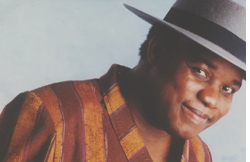|
 Kanda Bongo Man (Bongo, Kanda), Congolese singer; born Inongo, Congo-Kinshasa, 1955. Kanda Bongo Man (Bongo, Kanda), Congolese singer; born Inongo, Congo-Kinshasa, 1955.
Although his career was largely made in Paris, Kanda got his start in Kinshasa at the tail end of the belle epoque, the heyday of the Congolese rumba. He sang briefly beside Bella Bella singer Soki Dianzenza in Dianzenza's break away group Bella Mambo in 1976. Later the same year, Kanda and guitarist Diblo Dibala themselves broke away to form Bana Mambo (the children of Bella Mambo). That group stayed together for two years before breaking up in Uganda where they had gone on tour. Back in Kinshasa in 1979, Kanda worked a few months in a re-united Bella Bella before taking off for Paris.
Following more than a year of struggle, working odd jobs to support himself, Kanda met record dealer Ouattara Moumouni who was setting up his own label, Afro Rythmes. The pair made their first album, Iyole, together in 1981 with a quintet of musicians that included Diblo on lead guitar. Their first work was rough, but the stripped-down guitar, bass, and drums accompaniment and the speeded-up tempo of the rumba set the pattern for the future. The next year's effort, Djessy, with former Bella Bella guitarist Shaba Kahamba sitting in, showed strong improvement.
Kanda's lean, up-tempo, dance floor rumba was an agent of the evolving sound called soukous. Diblo's rapid picking butressed Kanda's engaging tenor in a combination that, by the mid-eighties, seemed unstoppable. Kanda, by this time producing himself, cranked out hit after hit starting with Malinga in 1985. What was perhaps his best album of the eighties, Sai-Liza (1987), helped to popularize a new dance craze from Kinshasa called kwassa-kwassa. Both Malinga and Sai-Liza were picked-up and re-packaged by the U.K./U.S. Hannibal label.
Diblo left to form his own group after recording Sai-Liza, but by then Kanda was such a sensation that the loss did little damage. Kanda played frequent concerts in Africa and Europe, and in 1989 made his first, and highly successful, tour of North America. Zing-Zong from 1991 added horns for the first time and was again picked-up by Hannibal. Another North American tour in 1992 yielded the CD Soukous in Central Park. Back home in Africa Kanda mixed soukous with voices and horns from the Johannesburg townships for the 1995 release Welcome to South Africa.
The nattily dressed, gap-toothed Kanda was an energetic performer who employed the best Congolese musicians from Paris and the latest dance steps from Kinshasa to striking effect. As a singer he valued lyrics, so his soukous represented more than a simple summons to the dance floor. In addition, he possessed a business sense that most of his colleagues seemed to lack. Kanda was one of only a handful of Congolese ever to make a lasting deal with a Western record label. His tours were well-organized and usually successful. As a result, Kanda enjoyed the highest profile of any of the musicians to emerge from the Congolo-Paris scene.
© 2011 Gary Stewart
SELECT DISCOGRAPHY
Amour Fou/Crazy Love (Hannibal HNCD1337) 1987; Kwassa-Kwassa (Hannibal HNCD1343) 1989; Zing Zong (Hannibal HNCD1366) 1991; Soukous in Central Park (Hannibal HNCD1374) 1993; Les Rendez-vous des Stades (B.Mas BMP950067) 1993; Welcome to South Africa (B.Mas BMP950053) 1995; Sweet (B.Mas BMP990134) 1999.
SELECT BIBLIOGRAPHY
C. Stapleton & C. May, African All-Stars (London, 1987); A. Bah-Diallo, "Kanda Bongo Man," Amina (no.226, Feb. 1989); R. Prince, "Candid Kanda," Folk Roots (no. 82, Apr. 1990); G. Stewart, Breakout: Profiles in African Rhythm (Chicago, 1992); G. Stewart, Rumba on the River (London and New York, 2000).
|

